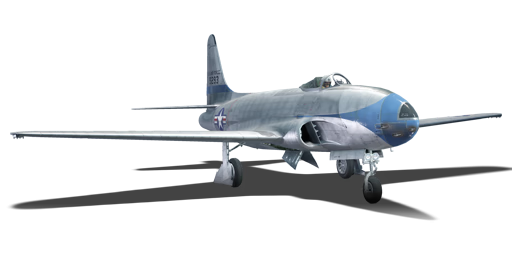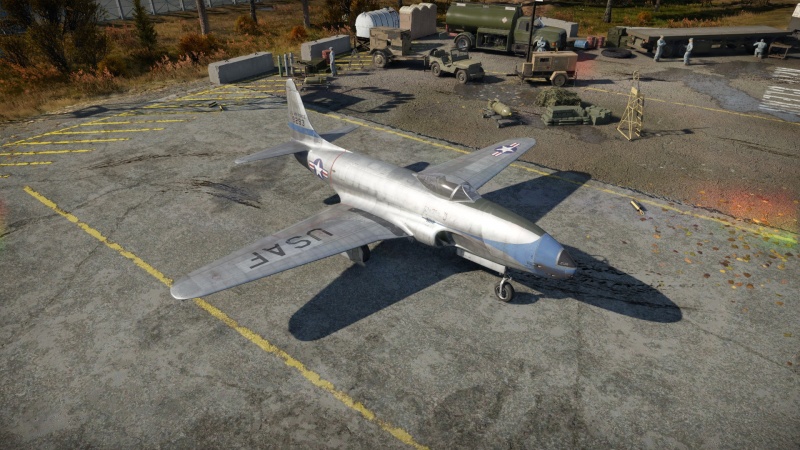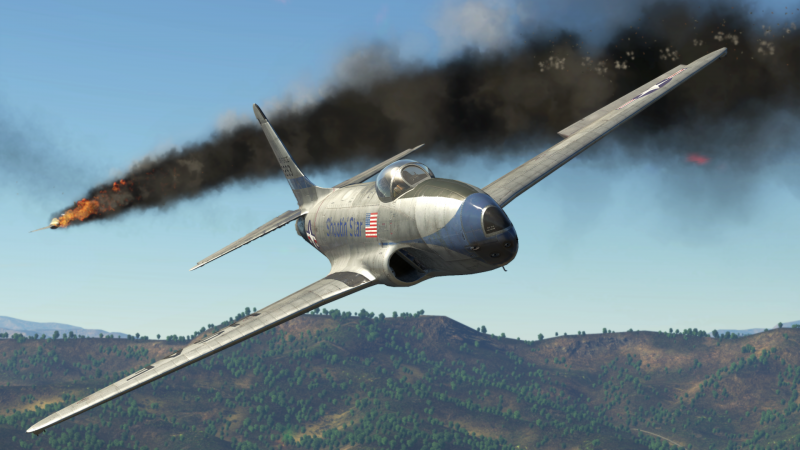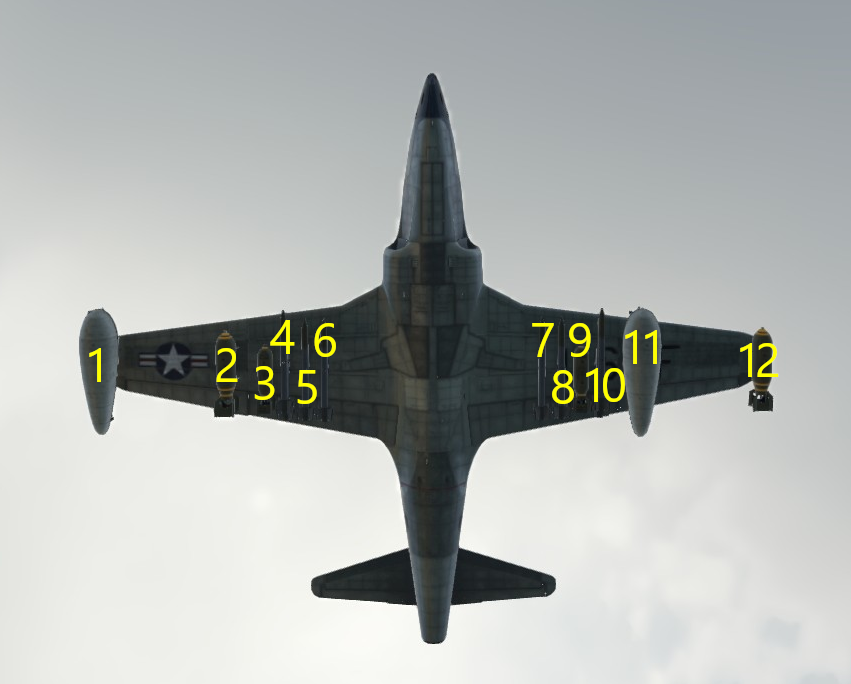F-80C-10
| This page is about the American jet fighter F-80C-10. For the other version, see F-80A-5. |
Contents
Description
The last production version of the P-80 Shooting Star was the P-80C. It was intended to have better engines and the first batches of P-80Cs had the Allison J33-A-23 engine. The last production batches had the more powerful Allison J33-A-35 engine that provided a 15% increase in thrust. Around 550 P-80Cs were fitted with the new engine. The P-80C also received the M3 Browning machine guns which boasted a very high fire rate. In 1948, the P-80C was redesignated as the F-80C. The vast majority of Shooting Stars that saw combat in the Korean War were F-80Cs and many were fitted with extra fuel tanks to increase endurance. The F-80C was in service until 1958 when the Air National Guard and Air Force Reserve retired them.
Introduced in Update 1.33, the F-80C-10 Shooting Star is a very good evolution of the F-80A-5. The new engine and M3 machine guns greatly increased the F-80C’s capability against fighters. The six M3 Brownings feature better range and fire rate which is a must-have for jet combat. The F-80C also has a better ground loadout and can carry up to four 1,000 lb bombs. The Allison J-33-A-35 comes with a water injection system that increases power up for around 100 seconds. Players should use this wisely as it’s quite limited; it’s particularly useful for accelerating from low speeds.
General info
Flight performance
| Characteristics | Max Speed (km/h at 0 m - sea level) |
Max altitude (metres) |
Turn time (seconds) |
Rate of climb (metres/second) |
Take-off run (metres) | |||
|---|---|---|---|---|---|---|---|---|
| AB | RB | AB | RB | AB | RB | |||
| Stock | 891 | 883 | 12500 | 24.3 | 25.5 | 18.7 | 17.3 | 850 |
| Upgraded | 915 | 903 | 23.7 | 24.0 | 32.2 | 25.2 | ||
Details
| Features | |||||
|---|---|---|---|---|---|
| Combat flaps | Take-off flaps | Landing flaps | Air brakes | Arrestor gear | Drogue chute |
| ✓ | ✓ | ✓ | ✓ | X | X |
| Limits | ||||||
|---|---|---|---|---|---|---|
| Wings (km/h) | Gear (km/h) | Flaps (km/h) | Max Static G | |||
| Combat | Take-off | Landing | + | - | ||
| 990 | 380 | 535 | 505 | 360 | ~10 | ~5 |
| Optimal velocities (km/h) | |||
|---|---|---|---|
| Ailerons | Rudder | Elevators | Radiator |
| < 482 | < 600 | < 640 | N/A |
Engine performance
| Engine | Aircraft mass | |||||
|---|---|---|---|---|---|---|
| Engine name | Number | Basic mass | Wing loading (full fuel) | |||
| Allison J33-A-35 | 1 | 4,500 kg | 262 kg/m2 | |||
| Engine characteristics | Mass with fuel (no weapons load) | Max Takeoff Weight | ||||
| Weight (each) | Type | 7m fuel | 20m fuel | 26m fuel | ||
| 814 kg | Centrifugal-flow turbojet | 4,882 kg | 5,472 kg | 5,775 kg | 6,962 kg | |
| Maximum engine thrust @ 0 m (RB/SB) | Thrust to weight ratio @ 0 m (WEP) | |||||
| Condition | 100% | WEP | 7m fuel | 20m fuel | 26m fuel | MTOW |
| Stationary | 1,980 kgf | 2,396 kgf | 0.49 | 0.44 | 0.41 | 0.34 |
| Optimal | 1,980 kgf (0 km/h) |
2,396 kgf (0 km/h) |
0.49 | 0.44 | 0.41 | 0.34 |
Survivability and armour
- 12.7 mm steel - behind the pilot
- 10 mm steel - in front of the pilot
- 38 mm bulletproof glass - armoured windscreen
Modifications and economy
Armaments
Offensive armament
The F-80C-10 is armed with:
- 6 x 12.7 mm M3 Browning machine guns, nose-mounted (300 rpg = 1,800 total)
Suspended armament
The F-80C-10 can be outfitted with the following ordnance presets:
- Without load
- 8 x HVAR rockets
- 8 x HVAR rockets
- 4 x 250 lb AN-M57 bombs (1,000 lb total)
- 4 x 500 lb AN-M64A1 bombs (2,000 lb total)
- 2 x 1,000 lb AN-M65A1 bombs (2,000 lb total)
- 4 x 1,000 lb AN-M65A1 bombs (4,000 lb total)
- 4 x Mk 78 incendiary bombs
Custom loadout options
| 1 | 2 | 3 | 4 | 5 | 6 | 7 | 8 | 9 | 10 | 11 | 12 | ||
|---|---|---|---|---|---|---|---|---|---|---|---|---|---|
| 250 lb AN-M57 bombs | 1 | 1 | 1 | 1 | |||||||||
| 500 lb AN-M64A1 bombs | 1 | 1 | 1 | 1 | |||||||||
| 1,000 lb AN-M65A1 bombs | 1 | 1 | 1 | 1 | |||||||||
| Mk 78 incendiary bombs | 1 | 1 | 1 | 1 | |||||||||
| HVAR rockets | 1, 2 | 1, 2 | 1 | 1 | 1 | 1 | 1, 2 | 1, 2 | |||||
| Maximum permissible loadout weight: 2,190 kg Maximum permissible wing load: 1,200 kg Maximum permissible weight imbalance: 800 kg | |||||||||||||
Usage in battles
Like most American fighters, your best option to attack is Boom and Zoom. At the start of the match, fly out towards the edge of the map. Climb at 2-3 degrees until you have reached ~770 km/h (~420 knots) at ~910 metres (~3,000 ft), then zoom climb at 20-30 degrees. Once you have slowed down to 287 km/h (155 kt), continue to climb at a solid 10 degrees. Optimally, you should have between 3.7-4.9 km (12,000-16,000 ft) depending on how high the highest enemy is, before turning towards the area of conflict (continue to climb or maintain altitude). Only once you have selected a target should you dive and make your pass. Always keep your energy high, whether it be speed or altitude. Because the F-80 is frequently uptiered, the best option is to dive on unsuspecting targets that are occupied engaging your teammates.
Defensive flying, rolling scissors, and to some degree, turn fighting, are options with the hydraulic boosters upgrade, as the straight wing as compared to 9.0 jets with swept wings provides better manoeuvrability at medium speeds (463-648 km/h, 250-350 knots). Any higher and the control surfaces begin to stiffen, any lower and you risk stalling out first, as jets with higher BR generally have a better thrust-to-weight ratio.
If you are given an awkward firing angle (e.g.: your target is near ground level and you are diving at a steep angle) or you fail to destroy them on your first pass, slowly pull your aircraft back up into a straight vertical climb to recover as much altitude as possible. If you persist on knocking out your target, you risk crashing into the ground from control stiffening or getting strafed by another enemy because you are losing your energy in a dogfight.
Pros and cons
Pros:
- Good acceleration and climb rate
- Effective weapons
- Can outturn MiG-15s when the need arises
- Very potent dogfighter, can out turn most planes that it faces
Cons:
- Relatively slow dive speed
- Average level flight speed
- Poor turn rate at 400-500 km/h
- Overall useless in a uptier, it is just too slow
- Just 100 seconds of WEP in RB, it is only there for emergencies
- Compresses at higher speeds
History
| Archive of the in-game description | |
|---|---|
|
An all-metal, single-seat fighter-bomber with one turbojet engine. The aircraft was created by a group of Lockheed engineers (headed by Clarence "Kelly" Johnson) in only 143 days. The first flight of the XP-80 prototype was performed in January 1944. The first production version, designated the P-80A Shooting Star, entered service in 1946. The P-80 became the first combat-capable jet aircraft to enter service with the USAAF. 1947 saw the appearance of the next production version of the aircraft, the P-80B. The ninth production P-80A-1 was converted to a new prototype, designated the XP-80B. It had an Allison J33-A-17 turbojet engine producing 1,816 kg of thrust, equipped with a methanol-water injection system. The airfoil was thinner, but the skin's thickness was increased. To install a water mixture tank, the plane's fuel quantity had to be sacrificed by reducing it from 1,781 to 1,610 liters The aircraft also received a Lockheed-designed ejection seat and a cockpit air-conditioning system. The plane's armament consisted of six 12.7 mm Colt-Browning M3 machine guns with 300 rounds each in the forward fuselage. One 1,000 lb (454 kg) bomb or ten 5-inch (127 mm) unguided HVAR missiles could be suspended under each wing panel. A total of 240 P-80B fighter-bombers were built from March 1947 to March 1948, including P-80B-1s and 31 P-80B-5s. The B-5 variant was intended to be operated in Arctic conditions; its heated canopy prevented icing. In addition, special types of oil and special rubber were used to operate the aircraft in low temperature conditions. At least five P-80Bs were equipped with a guidance system for Bell GAM-63 RASCAL air-to-surface missiles. Externally, these aircraft differed in the shape of the forward fuselage and the wing-mounted tanks. Also, they were fitted with extra spoilers on the upper and lower wing surfaces. In June 1948, when the US military aircraft designation system was changed, the P-80B was renamed to the F-80B. When the Korean War started, F-80Bs were stationed in the USA and in Europe, being used by the USAAF mainly for training purposes. Later, 117 F-80Bs were brought up to the F-80C's standards and re-designated "F-80C-12". The remaining F-80Bs were withdrawn from service by the end of 1951. | |
Notable pilots
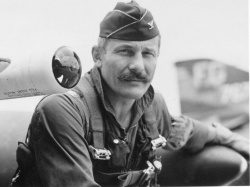
Media
- Skins
- Videos
See also
- Related development
External links
| Lockheed Corporation | |
|---|---|
| Fighters | XP-38G · P-38E · P-38G-1 · P-38J-15 · Bong's P-38J-15 · P-38K · P-38L-5-LO · YP-38 |
| Bombers | B-34 · PV-2D |
| Jet Fighters | F-80A-5 · F-80C-10 |
| F-104A · F-104C | |
| Strike Aircraft | F-117 |
| Export / License | A-29 · ▄Hudson Mk V |
| ␗P-38L-1 | |
| ␗F-104A · ▀F-104G · ␗F-104G · ▄F-104G · ▅F-104J · ▄F-104S | |
| The Lockheed Corporation merged with Martin Marietta Corporation in 1995 to form Lockheed Martin Corporation. | |
| See Also | SABCA · Mitsubishi Heavy Industries · Fiat Aviation |
| USA jet aircraft | |
|---|---|
| Fighters | |
| F9F | F9F-2 · F9F-5 · F9F-8 |
| F-80 | F-80A-5 · F-80C-10 |
| F-84 | F-84B-26 · F-84F · F-84G-21-RE |
| F-86 | F-86A-5 · F-86F-25 · F-86F-2 · F-86F-35 |
| F-89 | F-89B · F-89D |
| F-100 | F-100D |
| F-104 | F-104A · F-104C |
| F-4 | F-4C Phantom II · F-4E Phantom II · F-4J Phantom II · F-4S Phantom II |
| F-5 | F-5A · F-5C · F-5E · F-20A |
| F-8 | F8U-2 · F-8E |
| F-14 | F-14A Early · ▄F-14A IRIAF · F-14B |
| F-15 | F-15A · F-15C MSIP II · F-15E |
| F-16 | F-16A · F-16A ADF · F-16C |
| Other | P-59A · F2H-2 · F3D-1 · F3H-2 · F4D-1 · F11F-1 |
| Strike Aircraft | |
| FJ-4 | FJ-4B · FJ-4B VMF-232 |
| A-4 | A-4B · A-4E Early |
| A-7 | A-7D · A-7E · A-7K |
| AV-8 | AV-8A · AV-8C · AV-8B Plus · AV-8B (NA) |
| A-10 | A-10A · A-10A Late · A-10C |
| F-111 | F-111A · F-111F |
| Other | A-6E TRAM · F-105D · F-117 |
| Bombers | |
| B-57 | B-57A · B-57B |


